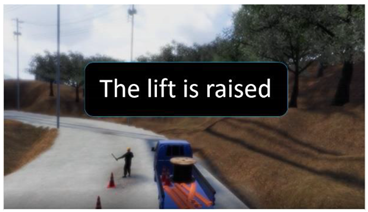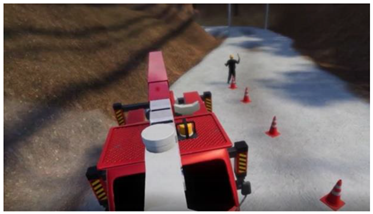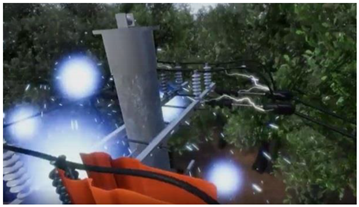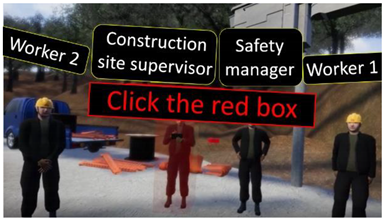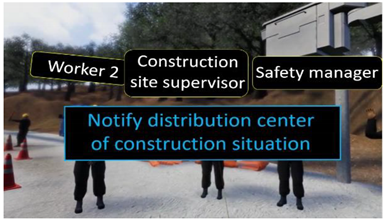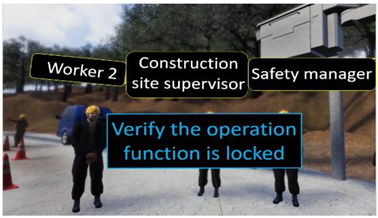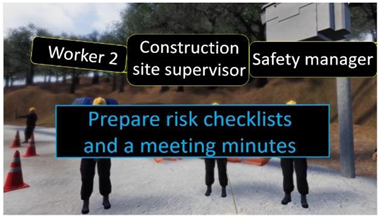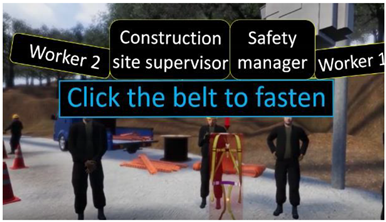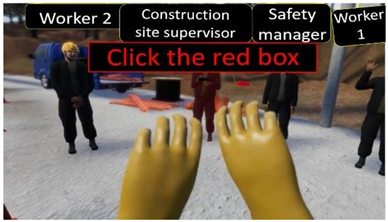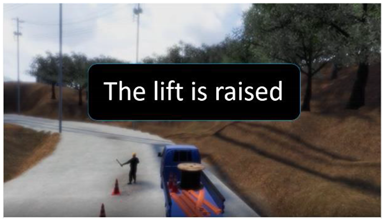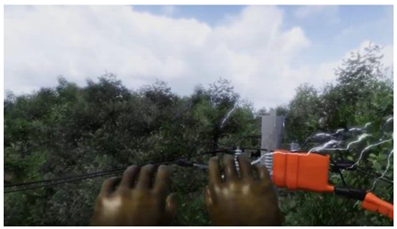Abstract
The current safety education and training system has a number of problems, namely that the actual risks in the field are not reflected and that workers cannot be engaged in safety education. Therefore, we conducted a study to build a VR-based safety education system that reflects the problems actually occurring in the field. The risk points of the electrical construction sites were derived through in-depth interviews with various stakeholders such as field workers, safety managers, and management. A risk scenario was also constructed by analyzing the causes and effects of existing accident cases. A safety education system was constructed to which the established risk scenario was applied. In the virtual construction site, the site’s own model, safety equipment, and members were implemented in a 3D model to form a virtual reality environment. This environment is intended to provide an educational environment wherein workers can immerse themselves in safety, specifically because this VR-based environment can induce active participation by providing safety information through various experiences. In addition, in this study, a VR-based safety education system that reflects the field conditions was designed to prepare basic data for the modernization and activation of safety education.
1. Introduction
To prevent the occurrence of industrial accidents and increase the efficiency of safety management within an organization, there is increasing emphasis on engagement with safety, such as by improving the safety awareness of members and establishing a safety management system that is suitable for the organization’s specific situation [1,2,3]. In particular, there is an increasing demand from companies and society for the development of education to encourage safety behaviors and focus on safety by reducing human error on the part of workers to improve site safety [4,5]. Safety education should include not only theoretical education but also experiential education that reflects the actual dangers of the field, such as training in evacuation and the proper initial response in the event of an accident.
Previous studies have confirmed that engagement was more effective in experience-oriented education than in theory-oriented instruction delivered through documents and audio-visual materials [6,7,8,9]. However, it is very difficult to directly implement the situation in such a way that workers who are being trained can experience the actual accident site; it is challenging to conduct experiential education to prepare for and respond to accidents. In addition, workers may be exposed to physical dangers during these experiential training courses [9,10,11]. Safety education and training using virtual reality (VR) has recently attracted attention as a possible way to counter the aforementioned problems.
Virtual reality means a specific environment or situation, or the technology itself, which is similar to the reality created by artificial technology using computers, etc. but is not real. VR-based education can device a workplace environment or situation that is highly similar to the actual one. VR implementations that are similar to the real world can reflect direct risks in the industrial field. Furthermore, these can maximize the learning-flow of workers by allowing them to partake in experiential education in a VR-based environment. For example, VR can be used to implement various industrial accident situations such as electric shock, jamming, and falling, without being restricted by time and space; drills reflecting these dangerous situations can be safely and repeatedly conducted [12,13,14,15]. Related studies in the past have reported that learning can be improved by experience sharing between learners who have received VR-based experiential education and training. Additionally, previous studies have reported that VR-based safety education had a positive effect on increasing workers’ understanding of safety rules. Furthermore, it has been suggested that VR-based safety education can provide experiential education and training that reflects the risks of real-world phenomena, thereby increasing workers’ safety awareness and allowing them to immerse themselves in safety in the work process [10,16].
Most of the existing research on VR-based safety education has been conducted on construction sites [6,9,17,18,19]. Research related to VR-based safety education and training has also been conducted in the field of evacuation simulation development research, such as marine safety training and fire safety training [9,11]. Recently, industrial field education based on virtual reality has been studied in various industries such as the manufacturing and automobile industry [20,21,22,23,24]. A mobile platform was developed that uses a smartphone device as a digital education tool by adding virtual reality application Android technology to the existing VR-based technology to educate workers using digital technology [21]. In addition, research on VR-based education is being conducted in the field of technical education in the industrial field based on immersion [24].
The effectiveness of experiential safety education and training reflecting risks in construction sites is being proven. According to previous studies, it was confirmed that providing education that reflects on-site risks based on virtual reality during experiential safety education and training has a positive effect on the induction of workers’ safety behavior and organizational safety achievement [17,18,19,24,25]. In the construction industry, automobile industry, manufacturing industry, as well as various industrial sites, it is necessary to provide an education and training environment where workers can focus on safety by improving their safety awareness and behavior without being directly exposed to dangerous situations.
Among the industrial fields, the education and training studies on active electric construction projects that are being performed are insufficient. Active electronic work is performed while an electric current is flowing through the living cables, and more than 80% of electric shock accidents occur during active electronic work, so there is a significant risk [20]. In addition, most of the causes of accidents at active electronic work sites are caused by human errors such as a lack of safety awareness among workers, work mistakes, and failure to wear safety equipment. In addition, there is a need to provide an education and training environment in which workers can concentrate on safety by improving their safety awareness and behavior without exposing themselves directly to dangerous situations.
Therefore, in this study, we attempted to build an experiential safety education system applying VR technology as a new form of safety education for workers in active electronic construction sites. In addition, this design of a VR-based safety education system was intended to prepare basic data for the modernization and activation of safety education.
2. Theoretical Background
2.1. Industrial Safety Education and Training
Safety education refers to learning that comprehensively develops the knowledge, motivation, skills, attitudes, and behaviors necessary to respond to and prepare for the risk of accidents such as human injury or property damage [26,27,28]. It can also be defined as an educational activity that enhances the knowledge and cognitive abilities required by workers to perform their work safely in the workplace, the skills required to act in compliance with safety, and the formation of safety consciousness and values [29]. In the field of VR-based occupational safety education research, safety education is defined as learning how to actively respond to potential risks through continuous education to induce safety behaviors of workers and reduce the likelihood of accidents and hazards [22,23,24,25]. Safety education is directly related to the survival of workers.
The importance of effective safety education is being increasingly emphasized to reduce industrial accidents in the field and establish a healthy safety culture [8,28,30]. Safety education is coming to be emphasized as a necessity to prevent industrial accidents, as more than 80% of various accidents are caused by human error, such as a lack of safety awareness among the workers and incomplete safety behavior. However, the current safety education training has several problems.
First, it does not have an experiential element. A preceding study that investigated the demands of safety education in industrial sites targeting field workers found a high preference for the main education methods to be in a practical context centered on the field, such as practice and experiential education [31]. However, in most safety education, except for the firefighting field, it is difficult to conduct safety education in an experiential manner due to high cost and high risk. Second, there is a lack of consideration of learning subjects in safety education. Since workers’ participation in learning is a key factor in the effectiveness and continuity of safety education, it is crucial to elucidate the learning characteristics of site workers [30]. In the Program for the International Assessment of Adult Competencies (PIAAC), a study analyzing the social structural characteristics of the phenomenon of non-participation in lifelong learning revealed that blue collar occupations are more disadvantageous to work and learning than white collar occupations. In addition, it was announced that people in the blue-collar occupational group had a low learning affinity and a weak desire to participate in learning.
A study of field workers found that in an environment where work and study were separated, blue-collar workers were less likely to learn and less willing to participate in learning [32]. However, at present, safety education is uniformly conducted in a formal or injectable form without considering the learning characteristics of industrial workers, and the effectiveness of safety education is not guaranteed [29,33,34]. Therefore, to increase the effectiveness of safety education, it is necessary to deviate from the existing injection-type education, reflect the actual dangers in the field, and establish a safety education system that suited to the learning characteristics of workers so that they can immerse themselves in learning.
2.2. Virtual-Reality-Based Safety Education and Training
Safety education using VR technology is attracting increasing attention as an innovative technology, and it is being used in various fields because it has the advantages of high practicality, high risk and high cost substitution, and securing safety and efficiency. Virtual reality can be defined as a virtual world similar to reality that acts a part of a person’s senses and feels real [2,16,35]. Education using virtual reality technology can solve the limitations of current safety education in the absence of learner’s immersion factors. First, VR technology can be used to implement experience-based safety education. When an experiential form of safety education is performed using VR technology, workers can actively participate in safety education that reflects the actual conditions of the field, thereby improving and improving safety awareness, as well as enabling them to concentrate on safety at work [18,36]. The engagement of these workers with safety practices in the workplace can lead to a reduced occurrence of industrial accidents.
Second, a flexible environment optimized for customized learning goals can enhance workers’ engagement in learning by providing concrete experiences with a sense of presence [9,14,35,36]. In addition, the study was reported that the implementation of experience-based safety education through VR technology can lead to active participation among workers that causes them to engage with safety [37]. Therefore, this technology can be expected to provide immersion, interest, and active participation in safety education targeting industrial site workers with low learning affinity and low learning needs, thereby offering an alternative to infusion-type education in which there is no experience factor, which was a limitation of the existing safety education.
VR-based educational contents can be classified into the realistic lecture type, simulation type, and game type contents according to the sense of presence offered. Among them, simulation-type educational content is the representative type that is the one most often used as safety education content because it has the advantage of making it possible to implement a realistic accident situation in virtual reality, which would have many restrictions in actual training [38]. VR-based safety education is used often in various fields because it transcends the limits of time and space in reproducing various accident sites, enables repeated learning as many times as desired, and has high learning effects. VR-based training has been applied in a number of fields, including safety education, construction, firefighting, automobile operation, heavy equipment driving training, aviation, disaster education, and national defense [6,39,40,41,42,43,44,45,46].
We examined various learning models for VR-based safety education described in previous studies. There are prior studies that try to provide VR-technology-based education and training by mixing pedagogical theory and immersion theory [21,22,23,24]. In this study, simulations and applications using immersive technology were built and designed so that users can experience the risks of real work in the virtual world and learn new skills [21]. VR-based education can also be used in the field of vocational education. Based on “knowledge learning”, it is configured to learn competency by applying cognition, attitude, knowledge, and technology [22,23]. It was designed to apply realistic training scenarios in the learning process of learners, and to enable faster access to knowledge by technicians and blue-collar workers. In addition, previous studies have suggested the use of a technology that can utilize a biosensor for user data collection and further enhance the sense of reality and application programs with the possibility of distance education [24].
Ho and Dzeng [27] presented a risk scenario comprising the main components of the VR-based safety education content design model, repetitive learning, and gamification, which allow learners to perform the same movement repeatedly until achieving safe behavior and which is more engaging than when the learner does not participate in the education, respectively. Education-based on gamification was applied not only to the construction field but also to research on the development of educational contents for chemical plants [47,48,49]. Lee [50] presented the several core factors necessary for VR-based content design: collecting information on accident situations to be implemented using VR technology, setting curriculum and educational goals in consideration of educational level and difficulty, etc., and creating realistic educational scenarios with which learners can engage. Chen et al. [51] applied reality to form the learner’s risk perception among the components of the existing safety education and training contents, such that the learner was immersed in the contents of education and the contents were embodied. An evaluation of educational effectiveness was also presented. Table 1 presents studies related to VR-based safety education. An evaluation of educational effectiveness was also presented. Table 1 presents studies related to VR-based safety education.

Table 1.
Research on VR-based safety education and training and its main contents.
Table 1.
Research on VR-based safety education and training and its main contents.
| Author(s) | Ground Theory | Application Field | Education Content Design Factors |
|---|---|---|---|
| Karagiannis et al. [21] | Immersion Theory and Gamification | Manufacturing |
|
| Mavrikios et al. [22] | Immersion Theory and knowledge learning | Manufacturing |
|
| Radhakrishnan et al. [24] | Immersion Theory and Embodied learning | Industrial skill |
|
| Adami et al. [25] | Behavioral-based safety program | Construction |
|
| Ho & Dzeng [27] | Gamification and e-Learning | Construction |
|
| Kim [38] | Behaviorist Learning Theory | Construction |
|
| Fracaro et al. [47] | Game-based learning | Chemical factory |
|
| Nykänen et al. [48] | Interaction TheoryLearner-Centered Curriculum | Construction |
|
| Chang, Chang, & Kim [49] | Simulation Theory | Construction |
|
| Lee [50] | Virtual Reality and Perception Theory | Construction |
|
| Chen et al. [51] | Embodied Cognition | Employee training |
|
| O’Briena, Cairns & Hall [52] | Transition Learning Theory | Employee training |
|
By analyzing the preceding studies, it may be confirmed that the educational design model using VR has a common element of engagement to check educational goals and contents, scenarios to be implemented in VR, and learners’ interests, actions, and reactions.
In the past, the focus was mainly on perceptual immersion, such as realism in a virtual space and experiences through senses. However, in recent years, psychological (or emotional) immersion has attracted attention; this type of immersion refers to human interest and motivation through interactions in VR [53], as well as the cognitive, emotional, and behavioral investment of learners when interacting in a virtual environment. There is a trend of expanding its meaning as an engagement that examines the quality of experience according to [54,55,56]. In the field of safety education, it has been difficult for learners to directly link safety knowledge to safety behavior as lecture-style education has become mainstream, because the actual situations cannot be applied in the educational programs due to the risk that learners may suffer safety accidents. When viewed comprehensively, safety education with VR technology can create real situations in VR that are free from the risk of accidents. Therefore, it is determined to be a new educational system that is notable in that it can achieve safety immersion through organic interaction between the learner’s cognition, emotion, and behavior. Figure 1 shows the main elements of VR-based education.
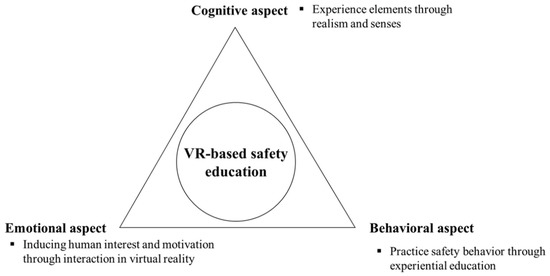
Figure 1.
VR-based safety education based on engagement.
3. Methods
Based on the necessity of VR-based safety education and the use of the learning model we have examined, a safety education system using VR supplements the limitations of existing safety education, thereby providing effective and high-quality education to field workers. It has been predicted that this will then contribute to the spread of a desirable safety culture. In this work, a study was conducted to lay the foundation for building a VR-based safety education system that reflects actual risks in industrial sites.
3.1. Risk Scenario Construction and 3D Modeling
In order to establish a VR-based safety education and training system, the accident process to be applied to the risk scenario for education and training was first selected. In-depth interviews were conducted with stakeholders such as site workers, safety managers, and management to select the accident process to be applied to the risk scenario. In addition, risk scenarios were established by deriving the risk points at the site through field trips and analyzing the causes and effects of existing domestic and international accident cases. The flow chart is presented in Figure 2.

Figure 2.
Risk scenario derivation process.
In high-voltage active electronic construction work, small mistakes can cause serious electric shock, so the following safety regulations must be observed:
- Do not allow electricity to flow into the human body. Workers must wear rubber insulation gloves, rubber insulation sleeves, insulated boots, and insulated hard hats.
- Precautions must be met during work (meeting with safety managers and co-workers).
- Before starting work, the detector must perform an operation test.
The 3D model design is a basic component of the safety training system for active electronic construction work. In this study, 3D images were produced that reflected the work site, the process before and after the work, and the risk points. Specifically, the material reflects the checklist necessary for safety management, such as before and after work, safety regulations, safety equipment, work schedules, and additional explanations related to safety management. The 3D model implemented in this study is of the one-person experience type. It was produced by comprehensively considering the surrounding environment. It included a user avatar, worker and manager characters, work equipment, trucks, safety facilities, and telephone poles. 3D Max (3D modeling program, Autodesk) was used to present the work process and the accident-related simulation and environment construction in 3D modeling.
3.2. Development of Safety Education and Training Contents
In this study, safety education contents were produced by reflecting electric shock and fall accidents that frequently occur in active electric construction work sites. The overall work procedure for a worker to take a lift and perform a cut-out switch (COS) replacement for a pole transformer of a direct active cable lines is shown, and differences are presented depending on the situation, such as whether the safety equipment was worn or if the meeting was held before work.
The educational contents were composed based on the established risk scenarios. The safety regulations implemented as factors causing industrial accidents in the content were composed based on occupational safety and health standards (OSHA) and the Korea occupational safety and health agency (KOSHA) guide.
3.3. VR-Based Safety Education and Training System Implementation
The safety education and training system in this study was produced for one person, and the system was largely composed of education and training contents (software, Secret Town Co., Ltd., Seongnam, Korea) and a tracking system. The education and training contents were produced based on user engagement. This content was produced with the overall knowledge of safety, work process, and safety regulations required before and after work execution as components. The tracking system constructed a motion recognition space using an optical motion sensor capable of tracking location and motion. This system is set up so that the user clicks through the work process and safety management checklist through the controller while the manager (a 3D character) that is shown on the screen provides an explanation of the work process and guidance on safety regulations. The head mounted display (HMD) is a key element in building a VR-based education and training system, and a 360-degree VR video program is applied so that there are no restrictions on the user’s motion. With this system, the risk cases were directly shown, and the accidents that occurred could be experienced in a manner similar to that in a real environment.
Virtualization devices (hardware) for education and training, Oculus Rift devices (Unity Technologies, San Francisco, CA, USA) were used (head mounted display and controller). It detects the user’s head movement through the head mounted display (HMD) device and operates by moving the screen according to the actual movement. The controller enables interaction with VR content using touch using a hand-held input tool. Since the content is displayed on a standing scale, a tracker product manufactured by HTC Vive(HTC Corporation, Taoyuan city, Taiwan) was used as a motion sensor so that the user’s location can be recognized.
4. Safety Education and Training System Platform Based on System Framework
4.1. System Design Principles and Components
In this study, the safety education and training system was constructed as follows by using the learner’s cognitive, emotional, and behavioral engagement of immersion theory in a virtual environment as a framework [55,56].
First, as an element of engagement in the cognitive aspect, the safety-related knowledge that should actually be acquired by users who participated in the safety education was presented. The main contents were electric shock and fall accidents, which occur most frequently at active electronic construction work sites of all types of danger and accidents. It is scientifically designed to present electric shock and fall accidents as risk scenarios and to help users learn safety knowledge through the experience of wearing safety protective equipment directly using a controller and HMD to prepare for safety accidents.
Second, to induce user engagement in the emotional aspect, the sound of the construction site, the vibration generated in the case of an accident, and the site’s manager and fellow workers—implemented as 3D characters—were all arranged appropriately. The user directly manipulating the controller made the VR experience highly real. Although this system is a one-person education and training system, it was set to interact with the safety manager implemented in the program, and it increased interest in safety education, which was somewhat difficult in the existing lecture-style classes, while also inducing education engagement.
Finally, we attempted to increase behavioral engagement wherein the superficially learned knowledge leads to direct action by implementing a thoughtful scene in VR that is difficult to experience in reality. After presenting the electric shock and fall accidents that occur frequently in the active electronic construction work site in VR, a thoughtful scene was presented where the learner could recognize the cause of the accident through simulating the accident situation. The simulation was composed of situations such as when the user did not wear insulation protection equipment or safety equipment before work, skipping the safety regulation checklist check, or simulating an alarm caused by an accident during work after omitting the equipment check. At this time, a reset function was inserted by applying the iterative learning element of gamification. Based on the contents of the active electronic construction work safety manual, it was intended to enhance the effectiveness of education by directly participating in actual safety actions. Ultimately, a VR-based safety education system was designed so that users who participated in safety education could perform actual safety behavior based on the safety knowledge acquired through the interaction between cognitive, emotional, and behavioral engagement.
4.2. User Module and Scene Interaction Module
Based on the design principle of active electronic construction work safety education, it was possible to understand the work procedure through a simulation of a COS (cutout switch) replacement for a direct live line column transformer. The importance of safety management was emphasized by adding accident factors and safety factors before and during work.
The VR situation is set to end with a different ending according to the user’s choices. First, the case involves the user not complying with the safety regulations. It was set so that an industrial accident would occur if the user did not communicate between the safety manager and fellow workers in the field and did not wear safety equipment. In addition, if the user checked the communication between the safety manager and field colleagues, it was set up so that an industrial accident would occur if the user did not wear safety equipment.
Occupational accidents can occur even if people observe all safety rules. Therefore, in this study, a situation in which an accident does not occur when workers comply with all safety regulations and a situation in which an accident occurs but does not lead to personal injury such as injury or death were divided into two categories. The educational scenario used as a case in this study assumes an accident. It is set such that if the user complies with the safety regulations and wears the equipment properly in the process of work, even if an accident occurs, it will not lead to serious accidents such as electric shock, fall, and death.
Users of the VR safety education and training system participate in training while using HMD devices and controllers that can respectively be used to view and interact with 3D environments. The workplace scenario applied to the system was presented in two categories: a safe situation and an accident situation. The first scenario is a situation of electric shock and fall that can occur when safety equipment is not worn. Table 2 presents the contents of educational contents in detail. It shows in detail how the process works when the education and training system begins. First, an accident case that can occur if the user does not wear safety equipment is shown. The user took the lift using the controller and performed the COS replacement work for the active cable pole transformer. An electric shock accident occurred while the user performed this active electronic construction work, and the situation ended with an electric shock and a fall accident for the user who was not wearing safety equipment.

Table 2.
VR simulation without safety equipment.
The second accident case is a situation in which the user is wearing safety equipment. Table 3 shows in detail the accidents and risks that can potentially occur when wearing safety equipment. The user clicks the safety manager, one of the 3D characters displayed on the screen through the controller and receives a checklist based on the live line work manual, an explanation of the work process, and a guide to the relevant safety regulations. The safety regulations are presented as a checklist, and the checklist is to check the status of active electronic work equipment and rubber protective equipment, then report the work status to the distribution center. One is also required to check whether the substation breaker or the power side recloser (R/C) is reclosed to stop the operation function. Next, it consists of contents such as maintaining a risk checklist and making minutes before live ship work. As confirmed in the last scene in the table, even if an accident occurs while performing active electronic work, wearing safety equipment can prevent a fatal accident.

Table 3.
VR simulation without safety equipment.
4.3. System Framework Workflow and Structural Design
A safety education system that applies VR technology was designed according to the theory and design principles related to safety education. First, immersion theory was applied as a theoretical basis for designing a safety education system based on VR technology, where the safety immersion of learners was specifically the main factor. We applied engagement as a design rationale by adding elements of user-system interaction and active participation to the existing immersion theory. The safety engagement of users was also a major factor. Safety commitment includes cognitive, emotional, and behavioral factors for safety, and the main constituents are safety compliance, safety consciousness, and safety behavior, respectively [8,57,58,59].
The risk scenarios applied to the system, including work processes, risk factors, and safety regulations, were constructed. The system was designed so that it can be flexibly changed according to the particular work process. The platform was designed so that the education system can be operated by applying different scenarios so that education can be applied in places other than construction sites, manufacturing sites, and industrial sites. Figure 3 shows the safety education system framework built by integrating theoretical analysis, system configuration and design principles, and technical elements.

Figure 3.
Learner-centered safety engagement education system framework.
The operating principle of the VR-based safety education and training equipment developed in this study was set so that results would differ depending on the user’s movements. Users can wear the HMD and move with the controller in one hand. The HMD and controller are wireless so that the user can freely move, and the main body can recognize the selection up to a radius of 2 m. Once the user clicks and selects the safety regulation checklist displayed on the HMD screen with the controller, and when the selection is completed, the checklist disappears and the site manager, safety manager, and fellow workers appear. The user communicates the site situation by clicking on the members one by one, and the safety manager explains the dangers of the work and instructs them to wear safety equipment. When the user clicks in response to the instruction, the scene in which the truck’s lift rises proceeds. The user performs work while moving in the lift. At this time, the motion sensor operates to check the user’s movement. A motion sensor is used to detect movement within the box, assuming the user is working inside the box inside the lift. If the user’s motion is out of range of the box or if a part of the body is detected close to the electric wire in VR, it vibrates to warn the user of danger.
4.4. Prototype Production of Safety Education and Training Systems
The prototype of the education and training system produced in this study received feedback from the expert group who participated in the interview when deriving the risk points of the electrical construction site. A total of 13 people participated in the demonstration of the product, including 7 electric construction site workers, 2 safety managers, and 4 site managers. In order to reflect the sense of reality in VR, workers at worksites provided feedback on the VR environment configuration, the safety regulation checklist, the immersion factors, and the work order. After the prototype was developed, whether the contents of the interviews with field personnel were reflected was confirmed through product demonstration. Figure 4 shows the manufacturing process of the prototype product.
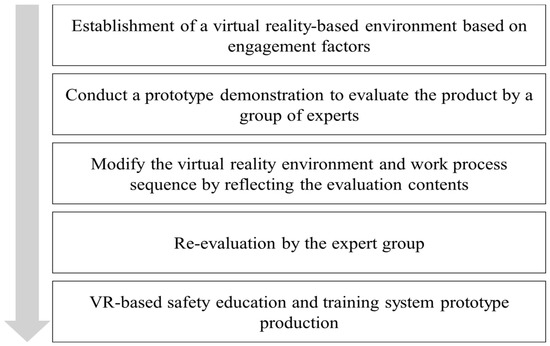
Figure 4.
Prototype development sequence.
5. Conclusions and Implications
In this study, to create an educational environment wherein people can immerse themselves in safety, an experience-based safety education system implemented using VR technology was established for active electronic construction site workers. Based on the research results, the following effects and implications of the new safety education system incorporating VR technology in cognitive, affective, and behavioral education were derived.
First, from a cognitive perspective, VR-based safety education can increase learning outcomes because it is more advantageous for acquiring knowledge than the existing lecture-oriented delivery methods. The advantage of using VR technology in safety education is the fact that it enables learning through risk scenarios and simulations that can realistically reproduce accident situations in a way that is impossible to do in reality [52,53,54]. Considering that practical experience through interaction is one of the most effective safety education and training methods, the use of VR-based safety education is expected to be high in the future. The VR-based safety education system developed in this study is an activity center that links the accident scene and education, enabling interaction-based experiential learning in which VR is realized in a real context. Through the demonstration of the prototype, it was estimated that the sense of presence provided by VR technology could contribute to the improvement of memory for content learning through a high sense of engagement. It is determined that it will provide a higher learning effect than simple lecture and injection type education.
Second, in terms of effectiveness, the effect of VR-based safety education can be examined in connection with the ‘presence effect’. The presence effect refers to the extent to which the VR has a lively feeling similar to reality that can maximize not only the cognitive aspect of memory enhancement but also the enjoyment of educational content based on the experience that increases the learner’s response to and energy toward the content. Based on educational content incorporating new technologies, learners can intuitively interact with the learning subject that is being visually expressed [40]. The VR safety education system developed in this study maximizes learning participation by providing experiential activities that allow learners to directly manipulate and interact with learning objects. By applying a gamification learning strategy using VR technology to support a variety of learning styles, the platform was configured to increase the learning participation, motivation, and satisfaction of multiple learners. This has substantial implications in that it can naturally induce interest and engagement in safety education, even among learners with relatively low learning affinity. VR education can help learners actively participate in safety education through emotional engagement such as by deriving motivation for learning and interest.
Finally, the behavioral engagement effect of VR education comes from its improvements to the learners’ behavior and the continuity of education practice free from the constraints of time and space. Unlike simple infusion lectures, in an environment implemented through VR, students can expect substantial behavioral improvement in that they directly participate in specific actions, such as the proper actions to take in dangerous situations consisting of accidents that occur when wearing or not wearing equipment [60,61,62,63]. In this study, the safety education and training system was designed so that learners can interact with the virtual environment based on VR technology and recognize the order of the work process, unlike the existing regular class method. In addition, VR education has an advantage in that it supports education and training that enables direct experience with the subject of learning while avoiding the potential risk of accidents that may occur in real situations in a safe environment. In particular, the development of a VR-based experiential safety education and training system for the process sequence and risk points of active electronic construction work is meaningful in that it adds diversity to the existing limited industrial fields such as construction, manufacturing, and plants.
As a prototype, the VR-based safety education and training system developed in this study is meaningful in that it is possible to perform user-centered education, to interact with users and the system, and to develop a curriculum for a new industry. However, this has some limitations that need to be addressed. First, because it is a one-person system, communication with field officials is not smooth. Since there is only one worker on the truck lift box when performing COS work, there was no problem in carrying out the job training itself. However, it did not reflect the situation in which communication with co-workers on the ground, safety managers, and field managers using radios, etc., was not considered. In addition, since the detection ability of the biosensor is limited to two people, it is difficult to conduct training for a large number of trainees.
The purpose of this study was to provide safety information through experiences using a VR-based environment to induce active participation and to provide an educational environment in which workers can immerse themselves in safety. The safety education and training system developed in this study can contribute to the establishment of a safety education system in which learners can continue to participate without an interruption of education, even at the present time when collective group education has become difficult due to the spread of COVID-19. Ultimately, the design of the safety education system is expected to contribute to improving the safety commitment in the workplace perceived by workers.
Future research could evaluate VR-based safety education and training system developed in this study from various perspectives. Specifically, in the initial stage, it is intended to educate users and evaluate curves of satisfaction, learning effect, and safety performance. The practical effect of the education and training platform and system developed in this study is to be tested and measured to verify the effectiveness of the existing education method. For the generalization of this platform and system, it is necessary to prove the effectiveness of training by designing for workers. In addition, cost benefits to organizations from choosing this training method over others based on a financial analysis are required.
Author Contributions
Conceptualization, H.J.S.; formal analysis, H.J.S., G.M.P. and M.S.; funding acquisition, A.-J.H.; methodology, H.J.S., G.M.P. and M.S.; project administration, A.-J.H.; software, G.M.P.; supervision, A.-J.H.; writing—original draft, H.J.S. All authors have read and agreed to the published version of the manuscript.
Funding
This research was funded by the National Research Foundation of Korea, grant number NRF-2020S1A3A2A02091529.
Institutional Review Board Statement
Not applicable.
Informed Consent Statement
Not applicable.
Data Availability Statement
Data sharing is not applicable to this article.
Conflicts of Interest
The authors declare no conflict of interest.
References
- Hofmann, D.A.; Morgeson, F.P.; Gerras, S.J. Climate as a moderator of the relationship between leadermember exchange and content specific citizenship: Safety climate as an exemplar. J. Appl. Psychol. 2003, 88, 170–178. [Google Scholar] [CrossRef]
- Michael, J.H.; Evans, D.D.; Jansen, K.J.; Haight, J.M. Management commitment to safety as organizational support: Relationships with non-safety outcomes in wood manufacturing employees. J. Saf. Res. 2005, 36, 171–179. [Google Scholar] [CrossRef]
- Zohar, D. Thirty years of safety climate research: Reflections and future directions. Accid. Anal. Prev. 2010, 42, 1517–1522. [Google Scholar] [CrossRef]
- Hofmann, D.A.; Morgeson, F.P. Safety-related behavior as a social-exchange: The role of perceived organizational support and leader-member exchange. J. Appl. Psychol. 1999, 84, 286–296. [Google Scholar] [CrossRef]
- Çakiroğlu, Ü.; Gökoğlu, S. Development of fire safety behavioral skills via virtual reality. Comput. Educ. 2019, 133, 56–68. [Google Scholar] [CrossRef]
- Son, J.W. Development of a student-centered leaning tool for construction safety education in a virtual reality environment. J. Korean Inst. Build. Constr. 2014, 14, 29–36. [Google Scholar] [CrossRef]
- Chang, G.Y.; Yang, Y.H. Innovation in Construction Education Using VR Technology. J. Korean Soc. Civ. Eng. 2017, 65, 84–87. [Google Scholar]
- Gao, Y.A.; Gonzalez, V.A.; You, T.W. The effectiveness of traditional tools and computer-aided technologies for health and safety training in the construction sector: A systematic review. Comput. Educ. 2019, 138, 101–115. [Google Scholar] [CrossRef]
- Pedram, S.; Palmisano, S.; Skarbez, R.; Perez, P.; Farrelly, M. Investigating the process of mine rescuers’ safety training with immersive virtual reality: A structural equation modelling approach. Comput. Educ. 2020, 153, 103891. [Google Scholar] [CrossRef]
- Kim, S.H.; Leem, C.S. Factors affecting the transfer intention of VR construction safety training: A task-technology fit perspective. Glob. Bus. Adm. Rev. 2020, 17, 300–318. [Google Scholar] [CrossRef]
- Shelbourn, M.; Aouad, G.; Hoxley, M. Multimedia in construction education: New dimensions. Autom. Constr. 2001, 10, 265–274. [Google Scholar] [CrossRef]
- Lindblom, A.; Laine, T.H.; Rossi, H.S. Investigating network performance of a multi-user virtual reality environment for mining education. In Proceedings of the 15th International Conference on Ubiquitous Information Management and Communication, Seoul, Korea, 4–6 January 2021. [Google Scholar] [CrossRef]
- Markopoulos, E.; Lauronen, J.; Luimula, M.; Lehto, P.; Laukkanen, S. Maritime safety education with VR technology (MarSEVR). In Proceedings of the 10th IEEE International Conference on Cognitive Infocommunications, Naples, Italy, 23–25 October 2019. [Google Scholar] [CrossRef]
- Meyer, O.A.; Omdahl, M.K.; Makransky, G. Investigating the effect of pre-training when learning through immersive virtual reality and video: A media and methods experiment. Comput. Educ. 2019, 140, 103603. [Google Scholar] [CrossRef]
- Popov, S.; Surchev, S.; Petkov, T.; Todorov, M.; Sotirova, E.; Sotirov, S.; Bozov, H.; Minkov, M.; Tankov, I.; Mitkova, M. Virtual reality as educational technology. In Proceedings of the 29th Annual Conference of the European Association for Education in Electrical and Information Engineering, Ruse, Bulgaria, 4–6 September 2019. [Google Scholar] [CrossRef]
- Jin, G.; Nakayama, S. Virtual reality game for safety education. In Proceedings of the International Conference on Audio, Language and Image Processing, Shanghai, China, 7–9 July 2014. [Google Scholar] [CrossRef]
- Son, J.W.; Shin, S.W.; Yi, J.S. Application of serious games for effective construction safety training. Korean J. Constr. Eng. Manag. 2014, 15, 20–27. [Google Scholar] [CrossRef]
- Park, J.W.; Lee, S.H.; Kim, S.H.; Won, J.H.; Yoon, Y.C. A study on safety information provision for workers using virtual reality-based construction site. J. Korean Soc. Saf. 2020, 35, 45–52. [Google Scholar] [CrossRef]
- Fard, M.G.; Pena-Mora, F. Application of visualization techniques for construction progress monitoring. In Proceedings of the International Workshop on Computing in Civil Engineering 2007, Pittsburgh, PA, USA, 24–27 July 2007. [Google Scholar] [CrossRef]
- Jung, Y.B.; Park, C.H.; Kim, G.H.; Jang, G.S. 3D immersion type virtual environment system: Training interruption-free live-line workers. Trans. Korean Inst. Electr. Eng. A. 2004, 53, 22–30. [Google Scholar]
- Karagiannis, P.; Togias, T.; Michalos, G.S.; Makris, S. Operators Training Using Simulation and VR Technology. In Procedia CIRP, Proceedings of the 8th CIRP Global Web Conference (CIRPe 2020), Patras, Greece, 14–16 October 2020; Elsevier: Amsterdam, The Netherlands, 2021; pp. 290–294. [Google Scholar]
- Mavrikios, D.; Papakostas, N.; Mourtzis, D.; Chryssolouris, G. On industrial learning and training for the Factories of the Future: A conceptual, cognitive and technology framework. J. Intell. Manuf. 2013, 24, 473–485. [Google Scholar] [CrossRef]
- Chryssolouris, G.; Mourtzis, D.; Stavropoulos, P.; Mavrikios, D.; Pandremenos, J. Knowledge Management in a Virtual Lab Collaborative Training Project: A Mini-Formula Student Car Design; Bernard, A., Tichkiewitch, S., Eds.; Methods and Tools for Effective Knowledge Life-Cycle-Management; Springer: Berlin/Heidelberg, Germany, 2008. [Google Scholar] [CrossRef]
- Radhakrishnan, U.; Koumaditis, K.; Chinello, F. A systematic review of immersive virtual reality for industrial skills training. Behav. Inf. Technol. 2021, 40, 1310–1339. [Google Scholar] [CrossRef]
- Adami, P.; Rodrigues, P.B.; Woods, P.J.; Becerik-Gerber, B.; Soibelman, L.; Copur-Gencturk, Y.; Lucas, G. Effectiveness of VR-based training on improving construction workers’ knowledge, skills, and safety behavior in robotic teleoperation. Adv. Eng. Inform. 2021, 50, 101431. [Google Scholar] [CrossRef]
- Bhandari, S.; Hallowell, M.R.; Correll, J. Making construction safety training interesting: A field-based quasiexperiment to test the relationship between emotional arousal and situational interest among adult learners. Saf. Sci. 2019, 117, 58–70. [Google Scholar] [CrossRef]
- Ho, C.L.; Dzeng, R.J. Construction safety training via e-learning: Learning effectiveness and user satisfaction. Comput. Educ. 2010, 55, 858–867. [Google Scholar] [CrossRef]
- Mayes, I.; Holyoke, L.B. Exploring pesticide safety education in Idaho. CTER 2019, 44, 56–87. [Google Scholar] [CrossRef]
- McGovern, E.; Moreira, G.; Luna-Nevarez, C. An application of virtual reality in education: Can this technology enhance the quality of students’ learning experience? J. Educ. Bus. 2020, 95, 490–496. [Google Scholar] [CrossRef]
- Park, K.O. Educational and ecological factors associated with workers’ participation to safety and health education at work—Based on the PRECEDE model. J. Korean Soc. Saf. 2016, 31, 74–83. [Google Scholar] [CrossRef][Green Version]
- Park, K.O. Multidimensional analyses on effective contents and methods of safety and health education perceived by safety and health managers at workplace. J. Korean Soc. Saf. 2017, 32, 89–99. [Google Scholar]
- Kim, H.S. The Study on the Socio-Structural Characteristic of the Voluntary Non-Participation in the Lifelong Learning—Based on the PIAAC Data. Ph.D. Thesis, Seoul National University, Seoul, Korea, 2016. [Google Scholar]
- Bong, J.K.; Won, J.H. Investigation of safety and health education improvement in construction sites using delphi technique and workers’ survey. J. Korean Soc. Saf. 2018, 33, 88–94. [Google Scholar] [CrossRef]
- Lee, Y.W. The current situation and prospect of safety education contents based on VR. J. Korea Inst. Inf. Commun. Eng. 2020, 24, 1294–1299. [Google Scholar] [CrossRef]
- Sankaranarayanan, G.; Wooley, L.; Hogg, D.; Dorozhkin, D.; Olasky, J.; Chauhan, S.; Fleshman, J.W.; De, S.; Scott, D.; Jones, D.B. Immersive virtual reality-based training improves response in a simulated operating room fire scenario. Surg. Endosc. 2018, 32, 3439–3449. [Google Scholar] [CrossRef]
- Lyou, C.G.; An, B.R. Educational characteristics of children’s virtual worlds. J. Korean Con. A 2009, 9, 177–186. [Google Scholar] [CrossRef]
- Kim, J.H. Development and Validation of Safety Commitment Scale. Ph.D. Thesis, The Catholic University of Korea, Seoul, Korea, 2019. [Google Scholar]
- Chertoff, D.B.; Goldiez, B.; LaViola, J.J. Virtual Experience Test: A virtual environment evaluation questionnaire. J. IEEE Virtual Real. Conf. 2010, 2422–2427. [Google Scholar] [CrossRef]
- Wang, P.; Wu, P.; Wang, J.; Chi, H.L.; Wang, X. A critical review of the use of virtual reality in construction engineering education and training. Int. J. Environ. Res. Public Health 2018, 15, 1204. [Google Scholar] [CrossRef]
- Chung, Y.K. Development of VR fire-extinguishing experience education contents using UX design methodology. J. Korean Con. A 2017, 17, 222–230. [Google Scholar] [CrossRef]
- Chae, J. Study on firefighting education and training applying virtual reality. Fire Sci. Eng. 2018, 32, 108–115. [Google Scholar] [CrossRef]
- Xie, Q.; Ding, X.; Jang, Y.J.; Yoon, T.S. Framework for car safety education virtual reality simulation. J. Korea Converg. Soc. 2019, 10, 37–45. [Google Scholar] [CrossRef]
- Chun, H.W.; Han, M.K.; Jang, J.H. Application trends in virtual reality. Electron. Telecommun. Trends. 2017, 32, 93–101. [Google Scholar]
- Park, H.J. A study on the effectiveness of airline safety VR education: Focusing on the relations safety VR education, emotional immersion and safety behavior. JTS 2019, 43, 31–47. [Google Scholar] [CrossRef]
- Lee, J.H. VR system environment technologies and user input elements. J. Korean Soc. Des. Cult. 2018, 24, 585–596. [Google Scholar] [CrossRef]
- Park, M.H.; Lee, S.S.; Jeon, K.S.; Seol, H.J. A Study on the development direction of education and training system based on AR/VR technology. J. Korea Inst. Mil. Sci. Technol. 2019, 22, 545–554. [Google Scholar] [CrossRef]
- Fracaro, S.G.; Chan, P.; Gallagher, T.; Tehreem, Y.; Toyoda, R.; Bernaerts, K.; Glassey, J.; Pfeiffer, T.; Slof, B.; Wachsmuth, S.; et al. Towards design guidelines for virtual reality training for the chemical industry. J. Chem. Educ. 2021, 36, 12–23. [Google Scholar] [CrossRef]
- Nykänen, M.; Puro, V.; Tiikkaja, M.; Kannisto, H.; Lantto, E.; Simpura, F.; Uusitalo, J.; Lukander, K.; Räsänen, T.; Heikkilä, T.; et al. Implementing and evaluating novel safety training methods for construction sector workers: Results of a randomized controlled trial. J. Saf. Res. 2021, 75, 205–221. [Google Scholar] [CrossRef] [PubMed]
- Chang, S.H.; Chang, H.J.; Kim, S.H. Types of virtual reality-based safety education contents. J. Korea Contents Assoc. 2021, 21, 434–445. [Google Scholar] [CrossRef]
- Lee, J.H.; Chang, S.H. Emergency situation safety education training VR content model design. JDCS 2021, 22, 41–49. [Google Scholar]
- Chen, J.; Liu, C.; Chang, R.; Gui, P.; Na, S. From traditional to VR-based online education platforms: A model of the mechanism influencing user migration. Information 2020, 11, 423. [Google Scholar] [CrossRef]
- O’Brien, H.L.; Cairns, P.; Hall, M. A practical approach to measuring user engagement with the refined user engagement scale (UES) and new UES short form. Int. J. Hum. Comput. Stud. 2018, 112, 28–39. [Google Scholar] [CrossRef]
- Chi, M. Three types of conceptual change: Belief revision, mental model transformation, and categorical shift. In Handbook of Research on Conceptual Change, 2nd ed.; Erlbaum: Hillsdale, NJ, USA, 2013; pp. 61–82. [Google Scholar]
- Leem, E.S.; Woo, T. Exploratory research on virtual reality contents design methods based on head mounted device. J. Korean Soc. Media Arts 2016, 14, 91–106. [Google Scholar] [CrossRef]
- Flavián, C.; Ibáñez-Sánchez, S.; Orús, C. The impact of virtual, augmented and mixed reality technologies on the customer experience. J. Bus. Res. 2019, 100, 547–560. [Google Scholar] [CrossRef]
- Seo, H.J.; Hong, A.J. A systematic literature review of research tends in safety leadership. J. Korean Soc. Saf. 2020, 35, 61–77. [Google Scholar] [CrossRef]
- Tsaramirsis, G.; Buhari, S.M.; Al-Shammari, K.O.; Ghazi, S.; Nazmudeen, M.S.; Tsaramirsis, K. Towards simulation of the classroom learning experience: Virtual reality approach. In Proceedings of the 3rd International Conference on Computing for Sustainable Global Development (INDIACom), New Delhi, India, 16–18 March 2016. [Google Scholar]
- Oah, S.; Na, R.; Moon, K. The influence of safety climate, safety leadership, workload, and accident experiences on risk perception: A Study of Korean manufacturing workers. Saf. Health Work 2018, 9, 427–433. [Google Scholar] [CrossRef]
- Kim, J.M. An empirical Study on the Accident Prevention of VR and AR Construction Safety Education. Ph.D. Thesis, Myongji University, Gyeonggi, Korea, 2019. [Google Scholar]
- Goldenhar, L.M.; Moran, S.K.; Colligan, M. Health and safety training in a sample of open-shop construction companies. J. Saf. Res. 2001, 32, 237–252. [Google Scholar] [CrossRef]
- Lim, K.; Kim, M.H. A case study of the experiences of instructors and students in a virtual learning environment (VLE) with different cultural backgrounds. Asia Pac. Educ. Rev. 2015, 16, 613–626. [Google Scholar] [CrossRef]
- Freina, L.; Ott, M. A literature review on immersive virtual reality in education: State of the art and perspectives. Proc. eLearning Softw. Educ. 2015, 1, 133–141. [Google Scholar]
- Reisoğlu, I.; Topu, B.; Yılmaz, R.; Karakuş, Y.T.; Göktaş, Y. 3D virtual learning environments in education: A meta-review. Asia Pac. Educ. Rev. 2017, 18, 81–100. [Google Scholar] [CrossRef]
Publisher’s Note: MDPI stays neutral with regard to jurisdictional claims in published maps and institutional affiliations. |
© 2021 by the authors. Licensee MDPI, Basel, Switzerland. This article is an open access article distributed under the terms and conditions of the Creative Commons Attribution (CC BY) license (https://creativecommons.org/licenses/by/4.0/).
